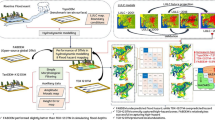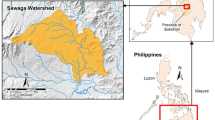Abstract
Flood risk analysis plays an essential role in flood warning systems and disaster prevention. The design flood is one flood event that probably occurs locally, drawn up for flood control design. Generally, the inundation of design floods under different return periods is simulated to determine the risk distribution of the area and to provide guidance for flood mitigation efforts. However, previous flood risk analysis studies have been stagnant at a large scale and crude level, with less practical guidance for regional or even individual flood prevention. In this study, we applied the digital terrain acquisition method to flood risk analysis, and finely analysed flood risk distribution for three disaster prevention object towns in China. The oblique photography technology of unmanned aerial vehicle flight was utilized innovatively in this paper and the one-two-dimensional coupling hydrodynamic model for design floods inundation was established based on the digital terrain results. Finally, the simulation results were superimposed on the high-definition orthophotos to meticulously analyse flood risk at the scale of the houses and to obtain fineness risk distribution, and a total of 42 high-risk houses, 866 medium-risk houses, and 600 low-risk houses were identified in their locations. This research is innovative, the results are reasonable and reliable, and the methods are of significant importance for both flood risk analysis and disaster prevention management. In addition, such approaches are easily transferable to other catchments or towns.
Graphical Abstract

















Similar content being viewed by others
Data Availability
The data generated or used during the study, if not proprietary or confidential, are available from the corresponding author upon request.
References
Annis A, Nardi F, Petroselli A, Apollonio C, Arcangeletti E, Tauro F, Belli C, Bianconi R, Grimaldi S (2020) UAV-DEMs for small-scale flood hazard mapping. Water. https://doi.org/10.3390/w12061717
Bilașco Ș, Hognogi G-G, Roșca S, Pop A-M, Iuliu V, Fodorean I, Marian-Potra A-C, Sestras P (2022) Flash flood risk assessment and mitigation in digital-era governance using unmanned aerial vehicle and GIS spatial analyses case study: Small river basins. Remote Sens. https://doi.org/10.3390/rs14102481
Bosch JL, Batlles FJ, Zarzalejo LF, López G (2010) Solar resources estimation combining digital terrain models and satellite images techniques. Renew Energy 35:2853–2861. https://doi.org/10.1016/j.renene.2010.05.011
Bulti DT, Abebe BG (2020) A review of flood modeling methods for urban pluvial flood application. Model Earth Syst Environ 6:1293–1302. https://doi.org/10.1007/s40808-020-00803-z
Caleffi V, Valiani A, Zanni A (2003) Finite volume method for simulating extreme flood events in natural channels. J Hydraul Res 41:167–177. https://doi.org/10.1080/00221680309499959
Casulli V, Stelling GS (1998) Numerical simulation of 3d quasi-hydrostatic, free-surface flows. J Hydraul Eng 124:678–686. https://doi.org/10.1061/(ASCE)0733-9429(1998)124:7(678)
Charalambous J, Rahman A, Carroll D (2013) Application of monte carlo simulation technique to design flood estimation: A case study for North Johnstone River in Queensland, Australia. Water Resour Manag 27:4099–4111. https://doi.org/10.1007/s11269-013-0398-9
Chen R, Qu R, Chen J, Lei J, Luo Y, Liu R, Ma Z (2022) A fast scheduling method for massive oblique photography 3D models. Wirel Commun Mob Comput 2022:8217220. https://doi.org/10.1155/2022/8217220
Collados-Lara A-J, Pardo-Igúzquiza E, Pulido-Velazquez D (2017) Spatiotemporal estimation of snow depth using point data from snow stakes, digital terrain models, and satellite data. Hydrol Process 31:1966–1982. https://doi.org/10.1002/hyp.11165
Debella-Gilo M, Etzelmüller B (2009) Spatial prediction of soil classes using digital terrain analysis and multinomial logistic regression modeling integrated in GIS: Examples from Vestfold County, Norway. CATENA 77:8–18. https://doi.org/10.1016/j.catena.2008.12.001
Diakakis M, Andreadakis E, Nikolopoulos EI, Spyrou NI, Gogou ME, Deligiannakis G, Katsetsiadou NK, Antoniadis Z, Melaki M, Georgakopoulos A, Tsaprouni K, Kalogiros J, Lekkas E (2019) An integrated approach of ground and aerial observations in flash flood disaster investigations. The case of the 2017 Mandra flash flood in Greece. Int J Disaster Risk Reduct 33:290–309. https://doi.org/10.1016/j.ijdrr.2018.10.015
Doneus M, Briese C (2006) Digital terrain modelling for archaeological interpretation within forested areas using full-waveform laserscanning 155–162. https://doi.org/10.2312/VAST/VAST06/155-162
Dung NV, Merz B, Bárdossy A, Apel H (2015) Handling uncertainty in bivariate quantile estimation – An application to flood hazard analysis in the Mekong Delta. J Hydrol 527:704–717. https://doi.org/10.1016/j.jhydrol.2015.05.033
El Alaoui El Fels A, Saidi MEM, Bouiji A, Benrhanem M (2020) Rainfall regionalization and variability of extreme precipitation using artificial neural networks: a case study from western central Morocco. J Water Clim Change 12:1107–1122. https://doi.org/10.2166/wcc.2020.217
Ferri M, Wehn U, See L, Monego M, Fritz S (2020) The value of citizen science for flood risk reduction: cost–benefit analysis of a citizen observatory in the Brenta-Bacchiglione catchment. Hydrol Earth Syst Sci 24:5781–5798. https://doi.org/10.5194/hess-24-5781-2020
Fleischmann A, Collischonn W, Paiva R, Tucci CE (2019) Modeling the role of reservoirs versus floodplains on large-scale river hydrodynamics. Nat Hazards 99:1075–1104. https://doi.org/10.1007/s11069-019-03797-9
Graf L, Moreno-de-las-Heras M, Ruiz M, Calsamiglia A, García-Comendador J, Fortesa J, López-Tarazón JA, Estrany J (2018) Accuracy assessment of digital terrain model dataset sources for hydrogeomorphological modelling in small mediterranean catchments. Remote Sens 10:2014
Gruss Ł, Wiatkowski M, Tomczyk P, Pollert J, Pollert J (2022) Comparison of three-parameter distributions in controlled catchments for a stationary and non-stationary data series. Water 14:293
Guo A, Chang J, Wang Y, Huang Q, Guo Z (2017) Maximum entropy-copula method for hydrological risk analysis under uncertainty: A case study on the Loess Plateau, China. Entropy 19:609
Hashemi-Beni L, Jones J, Thompson G, Johnson C, Gebrehiwot A (2018) Challenges and opportunities for uav-based digital elevation model generation for flood-risk management: A case of Princeville, North Carolina. Sensors. https://doi.org/10.3390/s18113843
Hidayah E, Halik G, Indarto I, Khaulan DW (2022) Flood hazard mapping of the Welang river, Pasuruan, East Java, Indonesia. J Appl Water Eng Res 1–12. https://doi.org/10.1080/23249676.2022.2114025
Hugenholtz CH, Whitehead K, Brown OW, Barchyn TE, Moorman BJ, LeClair A, Riddell K, Hamilton T (2013) Geomorphological mapping with a small unmanned aircraft system (sUAS): Feature detection and accuracy assessment of a photogrammetrically-derived digital terrain model. Geomorphology 194:16–24. https://doi.org/10.1016/j.geomorph.2013.03.023
Jakeman AJ, Littlewood IG, Whitehead PG (1990) Computation of the instantaneous unit hydrograph and identifiable component flows with application to two small upland catchments. J Hydrol 117:275–300. https://doi.org/10.1016/0022-1694(90)90097-H
Jamali B, Löwe R, Bach PM, Urich C, Arnbjerg-Nielsen K, Deletic A (2018) A rapid urban flood inundation and damage assessment model. J Hydrol 564:1085–1098. https://doi.org/10.1016/j.jhydrol.2018.07.064
Jiang Z, Duan J, Xiao Y, He S (2022) Elite collaborative search algorithm and its application in power generation scheduling optimization of cascade reservoirs. J Hydrol 615:128684. https://doi.org/10.1016/j.jhydrol.2022.128684
Kwon H-H, Sivakumar B, Moon Y-I, Kim B-S (2011) Assessment of change in design flood frequency under climate change using a multivariate downscaling model and a precipitation-runoff model. Stoch Env Res Risk Assess 25:567–581. https://doi.org/10.1007/s00477-010-0422-z
Lacroix MP, Martz LW, Kite GW, Garbrecht J (2002) Using digital terrain analysis modeling techniques for the parameterization of a hydrologic model. Environ Model Softw 17:125–134. https://doi.org/10.1016/S1364-8152(01)00042-1
Lei L, Chai G, Wang Y, Jia X, Yin T, Zhang X (2022) Estimating individual tree above-ground biomass of chinese fir plantation: Exploring the combination of multi-dimensional features from UAV Oblique Photos. Remote Sens 14:504
Li W, Lin K, Zhao T, Lan T, Chen X, Du H, Chen H (2019) Risk assessment and sensitivity analysis of flash floods in ungauged basins using coupled hydrologic and hydrodynamic models. J Hydrol 572:108–120. https://doi.org/10.1016/j.jhydrol.2019.03.002
Lin J, Wang M, Ma M, Lin Y (2018) Aboveground tree biomass estimation of sparse subalpine coniferous forest with UAV oblique photography. Remote Sens 10:1849
Loi NK, Liem ND, Tu LH, Hong NT, Truong CD, Tram VNQ, Nhat TT, Anh TN, Jeong J (2018) Automated procedure of real-time flood forecasting in Vu Gia – Thu Bon river basin, Vietnam by Integrating SWAT and HEC-RAS Models. J Water Clim Change 10:535–545. https://doi.org/10.2166/wcc.2018.015
Lyu H-M, Shen S-L, Zhou A, Yang J (2019) Perspectives for flood risk assessment and management for mega-city metro system. Tunn Undergr Space Technol 84:31–44. https://doi.org/10.1016/j.tust.2018.10.019
Mojaddadi H, Pradhan B, Nampak H, Ahmad N, Ghazali AHB (2017) Ensemble machine-learning-based geospatial approach for flood risk assessment using multi-sensor remote-sensing data and GIS. Geomat Nat Hazards Risk 8:1080–1102. https://doi.org/10.1080/19475705.2017.1294113
Nkwunonwo UC, Whitworth M, Baily B (2020) A review of the current status of flood modelling for urban flood risk management in the developing countries. Sci Afr 7:e00269. https://doi.org/10.1016/j.sciaf.2020.e00269
Pham BT, Luu C, Phong TV, Nguyen HD, Le HV, Tran TQ, Ta HT, Prakash I (2021) Flood risk assessment using hybrid artificial intelligence models integrated with multi-criteria decision analysis in Quang Nam Province, Vietnam. J Hydrol 592:125815. https://doi.org/10.1016/j.jhydrol.2020.125815
Quinn P, Beven K, Chevallier P, Planchon O (1991) The prediction of hillslope flow paths for distributed hydrological modelling using digital terrain models. Hydrol Process 5:59–79. https://doi.org/10.1002/hyp.3360050106
Rahman A, Weinmann PE, Hoang TMT, Laurenson EM (2002) Monte Carlo simulation of flood frequency curves from rainfall. J Hydrol 256:196–210. https://doi.org/10.1016/S0022-1694(01)00533-9
Reed DW (1994) Rainfall frequency analysis for flood design. In Coping with Floods, edited by: Rossi, G., Harmancioğlu, N., and Yevjevich, V., Springer Netherlands, Dordrecht 59–75. https://doi.org/10.1007/978-94-011-1098-3_5
Serinaldi F (2013) An uncertain journey around the tails of multivariate hydrological distributions. Water Resour Res 49:6527–6547. https://doi.org/10.1002/wrcr.20531
Vélez-Nicolás M, García-López S, Barbero L, Ruiz-Ortiz V, Sánchez-Bellón Á (2021) Applications of unmanned aerial systems (UASs) in hydrology: A review. Remote Sens 13. https://doi.org/10.3390/rs13071359
Wang H, Hu Y, Guo Y, Wu Z, Yan D (2022a) Urban flood forecasting based on the coupling of numerical weather model and stormwater model: A case study of Zhengzhou city. J Hydrol Reg Stud 39:100985. https://doi.org/10.1016/j.ejrh.2021.100985
Wang S, Jiang Z, Liu Y (2022b) Dimensionality reduction method of dynamic programming under hourly scale and its application in optimal scheduling of reservoir flood control. Energies. https://doi.org/10.3390/en15030676
Wu Z, Shen Y, Wang H, Wu M (2020) Urban flood disaster risk evaluation based on ontology and Bayesian Network. J Hydrol 583:124596. https://doi.org/10.1016/j.jhydrol.2020.124596
Xu Y, Jiang Z, Liu Y, Zhang L, Yang J, Shu H (2023) An adaptive ensemble framework for flood forecasting and its application in a small watershed using distinct rainfall interpolation methods. Water Resour Manag 37:2195–2219. https://doi.org/10.1007/s11269-023-03489-x
Xu Y, Liu Y, Jiang Z, Yang X, Wang X, Zhang Y, Qin Y (2022) Improved convolutional neural network and its application in non-periodical runoff prediction. Water Resour Manag 36:6149–6168. https://doi.org/10.1007/s11269-022-03346-3
Yalcin E (2019) Two-dimensional hydrodynamic modelling for urban flood risk assessment using unmanned aerial vehicle imagery: A case study of Kirsehir, Turkey. J Flood Risk Manag 12:e12499. https://doi.org/10.1111/jfr3.12499
Yu G, Lim S-Y (2003) Modified Manning formula for flow in alluvial channels with sand-beds. J Hydraul Res 41:597–608. https://doi.org/10.1080/00221680309506892
Zhang K, Shalehy MH, Ezaz GT, Chakraborty A, Mohib KM, Liu L (2022) An integrated flood risk assessment approach based on coupled hydrological-hydraulic modeling and bottom-up hazard vulnerability analysis. Environ Model Softw 148:105279. https://doi.org/10.1016/j.envsoft.2021.105279
Zhang R, Li H, Duan K, You S, Liu K, Wang F, Hu Y (2020) Automatic detection of earthquake-damaged buildings by integrating UAV oblique photography and infrared thermal imaging. Remote Sens 12:2621
Funding
This study was financially supported by the National Key R&D Program of China (2022YFC3002703), the Natural Science Foundation of China (52179016), Natural Science Foundation of Hubei Province (2021CFB597).
Author information
Authors and Affiliations
Contributions
Yichao Xu: Conceptualization, Methodology, Visualization, Data curation, Writing—Original draft preparation, Writing—Review & Editing. Xinyin Wang: Writing the introduction, Visualization. Zhiqiang Jiang: Validation, Software, Supervision. Yi Liu: Visualization, Investigation, Resources. Li Zhang: Project administration, Formal analysis. Yukun Li: Data processing of digital terrain.
Corresponding authors
Ethics declarations
Competing Interests
The authors declare that they have no conflict of interest.
Additional information
Publisher's Note
Springer Nature remains neutral with regard to jurisdictional claims in published maps and institutional affiliations.
Rights and permissions
Springer Nature or its licensor (e.g. a society or other partner) holds exclusive rights to this article under a publishing agreement with the author(s) or other rightsholder(s); author self-archiving of the accepted manuscript version of this article is solely governed by the terms of such publishing agreement and applicable law.
About this article
Cite this article
Xu, Y., Wang, X., Jiang, Z. et al. An Improved Fineness Flood Risk Analysis Method Based on Digital Terrain Acquisition. Water Resour Manage 37, 3973–3998 (2023). https://doi.org/10.1007/s11269-023-03535-8
Received:
Accepted:
Published:
Issue Date:
DOI: https://doi.org/10.1007/s11269-023-03535-8




